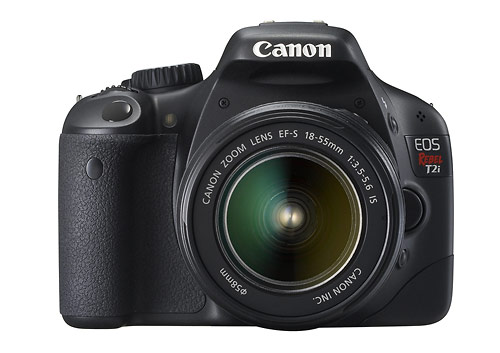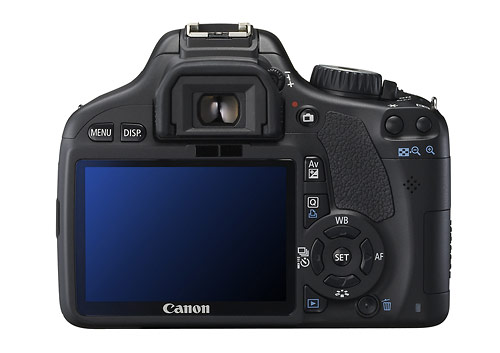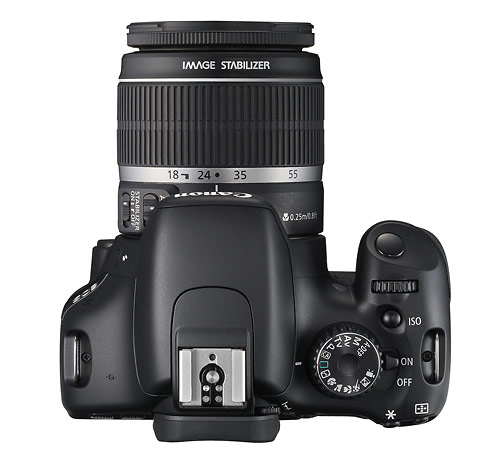 Canon is introducing a new camera to their entry-level EOS Rebel digital SLR line. The Canon EOS Rebel T2i will be the new flagship of the EOS Rebel line and it mixes features from the recently introduced EOS 7D and last year’s EOS Rebel T1i (EOS 500D). It inherits the Rebel T1i’s 9-point auto focus system and basic body design but it gets the 7D’s 18-megapixel CMOS sensor and 1080p HD video with full manual exposure control and a dedicated Live View / Movie button.
Canon is introducing a new camera to their entry-level EOS Rebel digital SLR line. The Canon EOS Rebel T2i will be the new flagship of the EOS Rebel line and it mixes features from the recently introduced EOS 7D and last year’s EOS Rebel T1i (EOS 500D). It inherits the Rebel T1i’s 9-point auto focus system and basic body design but it gets the 7D’s 18-megapixel CMOS sensor and 1080p HD video with full manual exposure control and a dedicated Live View / Movie button.
Key Canon EOS Rebel T2i Specs And Features:
- 18-megapixel CMOS sensor
- ISO 100-6400, extended to ISO 12,800
- DIGIC 4 processor
- 3.7 frames per second burst rate (34 high quality JPEG / 6 RAW)
- 9-point auto focus system
- 1080p video at 24, 25 and 30 frames per second; 60 frames per second at 720p
- Dedicated Live View / Movie mode button
- External microphone input
- Full manual video exposure
- New movie crop mode
- New 3-inch LCD with 3:2 ratio and 1-million dot resolution
- Pop-Up Flash
- New battery with 10% more capacity
- Quick Control button

Canon has a history of incorporating prosumer DSLR features into their entry-level Rebel cameras. The T2i gets the same 18-megapixel APS-C CMOS sensor as the Canon EOS 7D but with a 4-channel “readout” instead of the 7D’s faster 8-channel readout giving the T2i a maximum burst rate of 3.7 frames per second, about half the speed of the 7D. The T2i gets the complete video feature set from the EOS 7D – full HD 1080p video resolution at your choice of 24, 25 or 30 frames per second, or 60 FPS at 720p. This is impressive, especially since the T1i had a somewhat hamstrung 1080p HD video mode that only captured 20 frames per second. With such high-end video performance, the T2i reinforces Canon’s video-enabled DSLR dominance. With the T2i, they now offer full HD video with selectable frame rates and manual exposure control in four digital SLRs with prices starting at well under $1000. No other DSLR-maker comes close. The only thing Canon is missing is a model with a tilt-swivel LCD. Maybe that will be next?
As well as mixing high-end features into their “entry-level” DSLRs, Canon also has a tradition of using their Digital Rebel line to introduce brand new features. The T2i gets two new features – a new 2:3 ratio, 3-inch LCD with a one million-dot resolution and a “Movie Crop” mode. Besides the T2i’s general high-level spec, I think the new Movie Crop mode is probably the most interesting thing about the camera. It’s sort of an obvious feature when you think about. It uses the middle portion of the sensor for an approximate 7x magnification – or crop, if you want to get technical about it. Don’t confuse the Movie Crop mode with digital zoom, though. The T2i’s 1080p HD video resolution is about the same as a 2-megapixel sensor – only a small portion of the camera’s full 18-megapixel resolution. There’s no need for the in-camera interpolation (digital resizing) that makes digital zoom look so crappy. I haven’t seen any samples from the Movie Crop mode but it’s a great idea and technically there’s no reason it shouldn’t work well.
More than ever before, it seems like Canon is pushing the top-of-the-line Rebel DSLR as a serious camera. I’m sure Canon would like to sell more high-end cameras. But for most photographers I can’t help recommending the “entry-level” Rebel cameras over a 50D, 7D, 5D etc. I believe a lot of camera purchases are more ego-driven than based on what photographers really need. I’m as guilty of this as anyone else. We *want* the pro camera just because we want it, not because it will really help us take better pictures. The truth is, the new EOS Rebel T2i is plenty of camera for most of us, most of the time – even the pros. And if you’re a beginner, buying the Rebel T2i means you can spend more on a better lens – always a wiser way to invest your money.
Canon is calling the new T2i the “flagship” model of the EOS Rebel DSLR line. The XSi (450D) will be discontinued and the T1i (500D) will take its place as the mid-range model. The Rebel XS (1000D) beginner digital SLR will continue to be available. The Canon EOS Rebel T2i will sell for $899 with a lens and $799 body-only. Canon hasn’t been specific about when it will be available but late spring is a good bet.
Canon EOS Rebel T2i Press Release >>
Related Content:
Canon Digital SLR User Reviews
All Canon User Reviews
Canon Cameras Forum
All Canon News & Articles
Canon Cameras Web Site





Sweet! I’ve taken so many kick ass pictures with my 350d. This all but seals the deal for me.
The only thing that would push me to the higher end camera would be auto focus and viewfinder size. The Rebel 350d view finder is so damn small, and I’ve never been that impressed with the autofocus, and since it doesn’t have the old split screen viewfinder manual focus is a joke. I use the manual autofocus point selector a lot, but having something that was more sophisticated might be worth it.
Tilt swivel screen makes a lot of sense for video. I always use that when shooting video.
-M
Canon told me that the T2i uses the same AF system as the old EOS 30D. That puts it a few generations back compared to the current prosumer DSLRs. However, I’m pretty sure it’s a step up from the 350D, since the 30D was a high-er-end camera at the time. Spec-wise, the T2i / 550d looks really, really good. Of course, a 50D or 7D would give you a lot more performance. The question is, is it worth the extra money to you to get that performance. As I said in the article, the T2i will do most of what we need, most of the time.
I use a tilt-swivel LCD all the time for Live View, if I have one available. I’ve used it tons with the Olympus DSLRs and I was really pleased that Nikon put one on the D5000. I think it’s a really valuable feature for video and for still photographers shooting still subjects like landscape and studio work. If I’m using a tripod, I’m using Live View and I want a tilt-swivel LCD. It’s just a better way to work.
Hi Photo – John; when you say the 50D would give alot more performance, were you talking about fps or image quality?
Chris-
Sorry for not being more specific. For me, “performance” always means other than image quality. I’ll always say “image quality” when that’s what I’m talking about it. But there was no way for you to know that, huh? So yeah, I was talking about speed and auto focus. The 50D has better AF and it’s got a much faster frame rate. Image quality should be roughly the same. I do think the 18-megapixel sensor is better than the 50D’s sensor – especially at high ISO settings. Still, it would be nice if Canon would slow down on the pixel increases. I’d rather have improved noise control with the old 15-megapixel sensor. More pixels is nice. But it’s really not necessary – especially if it means compromised image quality.
I’ve been using Nikon for the last few years. If you take a smaller image than 18MP, would there be less noise at high ISOs and long exposures? Does the frame rate speed up? Thanks.
Jake-
The theoretical answer to all of your questions is, “yes.” However, as pixel counts rise, camera companies make faster processors and sensor architecture to keep up with the larger amount of data that needs to be handled. Case-in-point – the Canon EOS 7D uses the same sensor but with a larger data pipeline off the sensor and two processors instead of one. By doing that it has an 8 FPS burst rate instead of the 3.7 FPS burst rate of the T2i.
As for image quality, as pixels get smaller, noise increases. That’s just physics. That’s one of the reasons photographers go to full-frame cameras. The significantly larger sensors offer much better image quality because thy allow the same resolution with larger pixels. However, as with camera speed, as noise increases, camera companies come up with new noise-reduction strategies. So if you’re using an older, lower-resolution Nikon DSLR, it still might have more noise than a newer camera like the T2i / 550D. You also have to factor in the effect of resolution on apparent noise. If you have a 6-megapixel camera and a 12-megapixel camera with the same amount of noise, in a print, the 12-megapixel camera’s noise will be effectively minimized because it’s so much smaller than that of the 6-megapixel camera. That’s why “pixel peeping” – looking at images at 100% on the computer – isn’t really the best way to judge image quality. You really need to do it with prints.
I hope that helps. You might also want to look through or post on our Digital SLRs forum. There’s a lot more information there and it’s a more active place to discuss this kind of stuff
Thanks for the information, but was wondering about this using this camera in particular, because with its feature set, I’m thinking about jumping ship. I’m assuming that it has several image size settings in the menu, and I was wondering if using the next size down from 18MP decreases noise in the resulting image, perhaps by interpolating the sensor pixels in adjacent positions. The demo shots at dpreview are impressive (http://www.dpreview.com/previews/CanonEOS550D/page13.asp), but there is noticeable noise in the shadows of higher ISO images. Of course, I could mitigate noisy pixels using software, but I would imagine the camera designers could optimize performance in several areas by combining the output of sensor pixels (as a menu option).
Prints schmints — Judging image quality should be done in the final intended medium, whatever that is
I too wish this was left at 15MP with improvements focused on noise control instead.
t2i or 7d ? i
hello, I´m terribly undecided between the t2i and the d5000, is there any of the two you would recomend over the other? Trying to keep a little away from the video part, but rather image quality?
I’m starting photography classes soon and I wanna buy a new camera. I’m hesitating between 2 cameras; Nikon D90 or Canon EOS Rebel T2i . Which one should I pick ?! Thanks for your help
The new Canon EOS Rebel T2i is certainly an improvement over the previous EOS Rebel T1i with its higher resolution, large LCD 3:2 i-FCL to 63 areas and ample opportunity for Full HD video recording, but not sufficient in our opinion outpace the rival Nikon D90. If the video shoot for you is an important requirement for the superiority of the EOS Rebel T2i is clear, if the picture back is your main interest we think globally than the Nikon D90, which also offers its own decent chance of shooting video. If not already own a set of lenses of either brand or personal preferences toward any of them, we would like to recommend the D90 as the best buy between two cameras.
Hi,
I was looking for info about getting an object closer focusing on it and came across to your site.
I got the T2i with kit lens 18-55mm with IS, and couldn’t find in manuals and online any information about my question. One site says to use zoom, but it doesn’t help as it just brings close but without focusing – object is blurred. So could you please help me with my question.
Thank you,
Jerminal
Jerminal-
Welcome to PhotographyREVIEW.com! This question is reallly one for our forums. But I can give you a little direction now
Basically, you need a specialized “macro” lens. Compact cameras all have some built-in close-up shooting abilities. That’s not the case with digital SLRs like your T2i. To really get close you’ll need to buy a lens that’s made for close-up shooting. I use the Canon 50mm f/2.5 Macro lens for closeup work in the studio. It’s an inexpensive way to go but there are lots of options and what’s right for you will depend on what you want to shoot and how much you have to spend. I recommend you post a new question with some more information on our Digital SLR forum: http://forums.photographyreview.com/forumdisplay.php?f=5
I hope that helps
I am looking to purchase the Canon EOS Rebel T2i for a family member for Christmas and was wanting to get a lens that was a step up from the one that comes on this camera. I know the “kits” for them cost around $1000 but can anyone actually tell me what lens I should be looking for??
Thank you so much for your help on this matter.
Tori